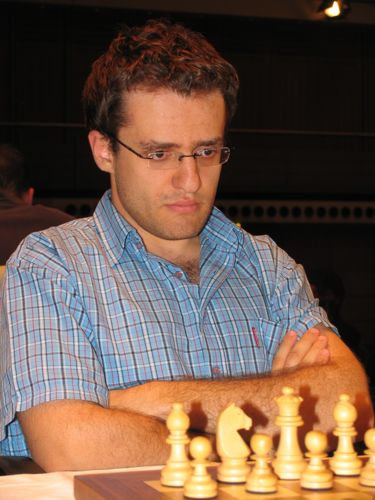
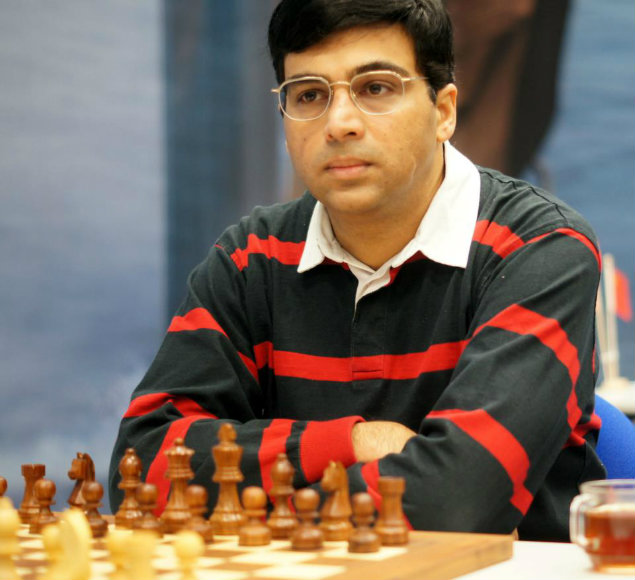
Aronian, Levon - Anand, Viswanathan
Wijk aan Zee 2013
1.d4 d5 2.c4 c6 3.Nf3 Nf6 4.Nc3 e6 5.e3 Nbd7 6.Bd3
The 1991 Karpov-Anand games revolved around the line 6.Qc2 Bd6 7.Be2 0-0 8.0-0 dxc4 9.Bxc4 and now 9...Qe7 or 9...a6.
6...dxc4 7.Bxc4 b5 8.Bd3 Bd6
Anand spent a lot of time choosing the bishop move over the Meran variation 8...a6 9.e4 c5.
9.0-0 0-0 10.Qc2 Bb7 11.a3 Rc8!?
The rook helps black to break with c6-c5 and white has no way to stop it. It is an improvement on 11...a6 that can be met by 12.Ng5 Bxh2+ 13.Kxh2 Ng4+ 14.Kg1 Qxg5 15.f3 Ngf6 16.e4 Qh4 17.Be3 and with strong center and a bishop pair, white has an excellent compensation for a pawn, as was played, for example in the game Anand-Aronian, Linares 2009. The roles were now reversed.
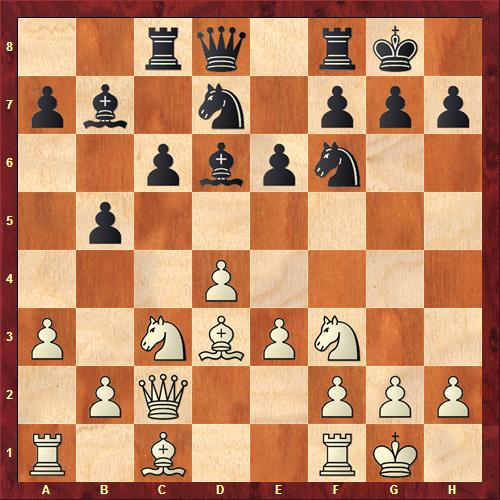
12.Ng5
Luring Anand to the same positional trap 12...Bxh2+ 13.Kxh2 Ng4+ 14.Kg1 Qxg5 and now after 15.f3 Ngf6 16.b4 white was better in Wojtaszek - Negi, German Bundesliga 2012.
The c-pawn can't be chained with 12.b4 because black can still play 12...c5! as Anand's team found out, concluding it leads to a draw after 13.bxc5 Bxf3.
And these were the reasons:
A. 14.gxf3 Nxc5! An amazing temporary piece sacrifice, equalizing the chances. 15.dxc5 Rxc5 and now trying to keep the piece leads to a draw: 16.Bb2 Bxh2+ 17.Kxh2 (17.Kh1 Nd5-+) 17...Rh5+ 18.Kg2 Rg5+ with perpetual check.
In the game Topalov -Kasimdzhanov, London 2012 white protected his king side, but lost the piece back 16.f4 Nd5 17.Bb2 Nxc3 18.Bxc3 Qc7 19.Rfc1 Rc8 and drew in 37 moves.
B. Another Anand's second, Ganguly, played 14.cxd6!? against Zherebukh in Fujairah City 2012, and after 14...Nd5 15.gxf3 Nxc3 16.f4 Nf6 17.Qb2 black could have played 17...Qd7!?, for example 18.Bd2 e5!, threatening 19...Qg4+ and equalizing. Instead he played 17...a6 and lost in 48 moves.
12...c5!
Everything breaks loose. When black's pieces aim at the white king, a couple of pawns is not important. It is stronger than grabbing the pawn: 12...Bxh2+ 13.Kxh2 Ng4+ 14.Kg1 Qxg5 15.f3 Ngf6 16.b4 and white had the edge in Wojtaszek - Negi, German Bundesliga 2012.
After the passive 12...g6 white succeeds tying black up with13.Nge4 Bb8 14.b4.
13.Nxh7
Aronian wins a pawn, but his knight gets stranded. Anand was sure that after 13.Bxh7+ Kh8 black is fine.
13...Ng4!
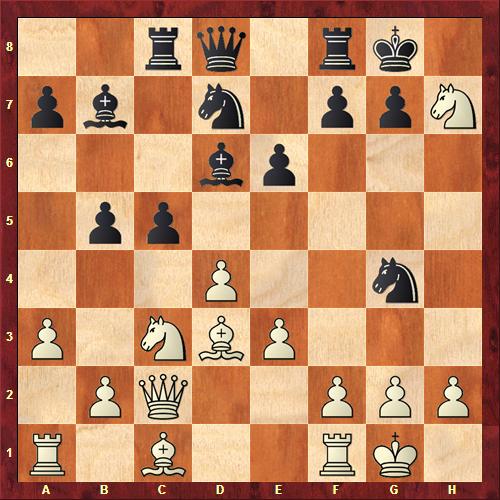
Rubinstein's final attacking sequence also begins with this
knight leap. Anand pointed out that from the time consumption it was
clear he tried to check and recheck his analysis, but it was nice to
have this position as a starting point. He knew that black's chances are
good and he could play with confidence. Not as good is 13...c4 14.Nxf6+
Nxf6 15.Be2 with white's edge.
14.f4
Aronian blocks the diagonal h2-b8, but Anand finds a clever way to find a new roadway for his dark bishop. The computers suggest that the position is still level after 14.h3 Bh2+! - an important check according to Anand - 15.Kh1 Qh4 black has plenty of counterplay, for example:
A. 16.d5 16...Rfd8 17.f3 (17.f4 b4 18.Ne4 c4=) 17...c4 18.Be4 Be5 19.fxg4 Nc5=;
B. 16.Be4 Bxe4 17.Qxe4 f5! 18.Qxe6+ Kxh7 19.Qxd7 Bb8 20.Kg1 (Or 20.f4
cxd4 21.Qxd4 Nf2+ 22.Kh2 Rfd8 and white can't cope with the activity of
black pieces.) 20...Bh2+ 21.Kh1 Bb8 leads to a repetition.
Taking the exchange 14.Nxf8? leads to a disaster after 14...Bxh2+ 15.Kh1 Qh4 and black wins.
14...cxd4!
The exchange sacrifice weakens white's center. Anand used 30 minutes for this move. Black has fully equalized. It is a critical moment for white.
15.exd4?!
This was the right time to capture the exchange 15.Nxf8 Bxf8 16.h3! (After 16.exd4? Ndf6! white can't protect the d-pawn and after 17.h3 Qxd4+ 18.Kh1 black wins with either 18...Bc5! or 18...Nh5.) 16...dxc3 17.hxg4 with roughly equal chances, for example:
A. 17...Qh4 8.g5 cxb2 19.Qxb2 Nc5 20.Qe2 Nxd3 21.Qxd3 Qg3 22.Ra2 Bd5 23.Rc2 a5=
B. 17...Nf6 18.Rd1 (18.g5? cxb2-+) 18...Qb6=
15...Bc5!
This astonishing bishop sacrifice is designed to gain the diagonal g1-a7. It took Aronian aback.
16.Be2?
Aronian perhaps underestimated black's next move. Otherwise he would have opted for 16.dxc5!? Nxc5 with black's edge, for example:
A. 17.Qe2 - Aronian: I am worse because the bishop on b7 is such a monster. - 17...Qd4+ 18.Kh1 Nxd3 19.Qxg4 Kxh7.
B. 17.h3!? Nxd3 18.Nxf8 Qd4+ 19.Kh1 Ndf2+ 20.Rxf2 Nxf2+ 21.Kh2 Kxf8.
16...Nde5!!
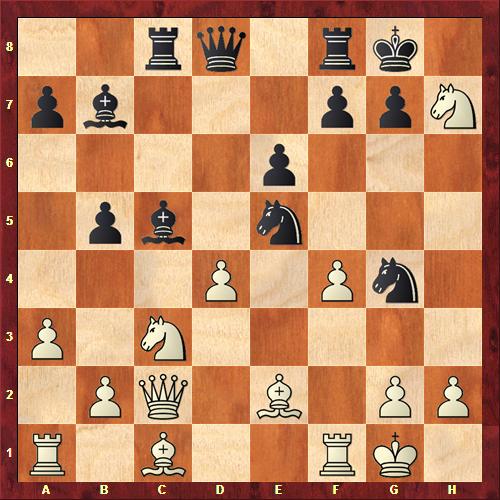
Anand's pieces walk on hot embers without getting burned. The
world champion is not showing off, it is the most precise way to
victory. He could have tried to take different paths, for example:
A. 16...Bxd4+ 17.Kh1 Ndf6 since 18.Bxg4? Nxg4 19.Nxf8 leads to the game, but white can spoil the fun with 18.Nxf6+.
B. 16...Qh4 17.Bxg4 Bxd4+ 18.Kh1 Qxg4 19.Nxf8 Nf6 20.Qe2 Qh3 21.f5 e5 22.Rf3 Bxf3 23.Qxf3 Qh4 and white can still play.
17.Bxg4
The other knight can't be taken: 17.fxe5 Qxd4+ 18.Kh1 Qg1+ 19.Rxg1 Nf2 mate.
White gets also mated after 17.dxc5 Qd4+
A. 18.Be3 Qxe3+ 19.Kh1 Qh3, threatening 20...Qxh2 mate.
B. 18.Kh1 Nf2+ 19.Rxf2 Qxf2 and black mates either on g2 or on the first rank.
17...Bxd4+ 18.Kh1 Nxg4 19.Nxf8
After 19.Ng5 f5 20.h3 Rf6 wins.
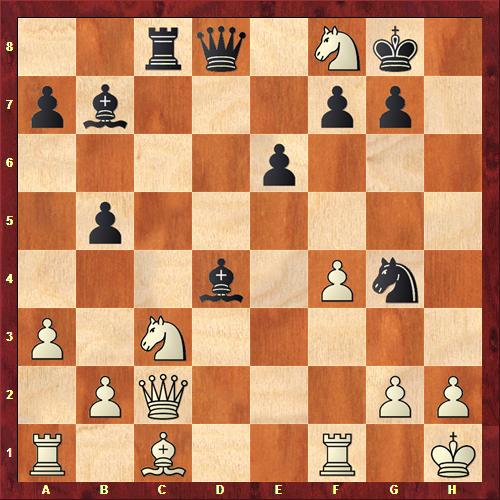
19...f5!
Anand was proud of this move. White is lost. There was no reason to allow white to escape after 19...Qh4 20.Qh7+.
20.Ng6
Preventing the queen sortie 20...Qh4 for the time being. Black wins after 20.Qd3 Qh4 21.Qg3 Qxg3 22.hxg3 Kxf8 23.Rd1 (23.Nd1 Ke7 threatening 24...Rh8 mate.) 23...Bxc3; or after 20.Qe2 Qh4! 21.Qxe6+ Kxf8 22.Qxf5+ Kg8 23.Qe6+ Kh8.
20...Qf6 21.h3
Other moves would not help either 21.Qd3 Qxg6 22.Qg3 Nf2+-+; or 21.Ne5 Nxh2! 22.Rf2 Qh4 23.Kg1 Qg3-+.
21...Qxg6 22.Qe2
After 22.hxg4 Qh6 mates.
22...Qh5!
Threatening 23....Qxh3 mate. It is the queen, not Rubinstein's rooks, that finishes white off.
23.Qd3
The game deserved the following brilliant ending: 23.Qxe6+ Kh8 24.Nd5 Rd8 25.Qe7 Qxh3+!!
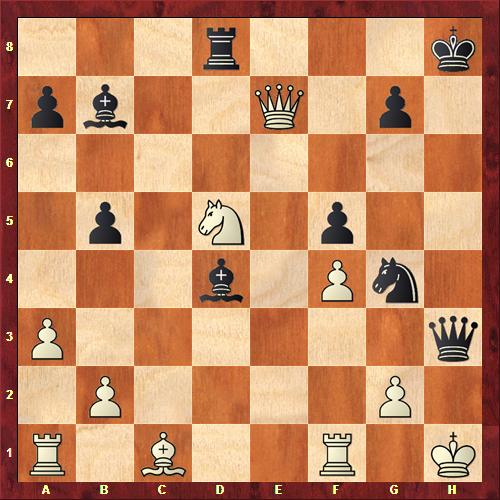
26.gxh3 Bxd5+ black mates soon.
White could have only prolonged the suffering with 23.Rf3 Nf2+ 24.Kh2
(24.Rxf2? Qxh3+ 25.Kg1 Qxg2 mate.) 24...Bxf3 25.Qxf3 Qxf3 26.gxf3 Bxc3
or 26...Nd3 and there is no doubt about black's victory.
23...Be3!
Blocking the defense of the h-pawn and threatening to mate with 24...Qxh3+. And after 24.Bxe3 Qxh3+ 25.Kg1 Qxg2 mates.
White resigned.
The game Rotlewi - Rubinstein was played at the Lodz club championship in 1907. Lodz was at that time a large textile Polish city that was a part of the Russian Empire. Rotlewi's career was cut short. He died in 1920 at the age of 31. Rubinstein became one of the best players in the world before World War I.
Andrew Soltis ranks Rubinstein's signature masterpiece as number 10 in his book The 100 Best Games of the 20th Century, Ranked, published by McFarland. It is a model game on how to act in symmetrical positions. White's inaccurate opening play is punished by three incredible rook moves, making it one of the most famous combinations.
The parallels with Anand's game are striking: the same knight leap
into the attack, a bishop pair on the same diagonals bearing down on the
white king at the same corner and the decisive queen sortie to the
h-file.
